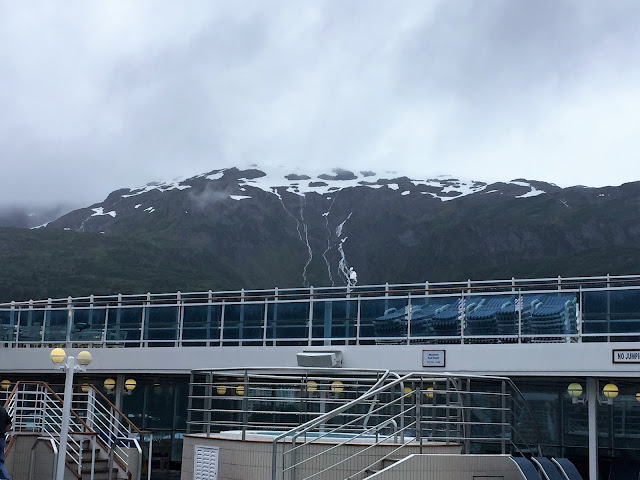Our first week of wandering on our own all over Alaska had come to an end, and it was time to get on the cruise ship. (We wholeheartedly recommend our itinerary of self-directed travel + cruise.)
We had to drive from Seward all the way back to Anchorage to drop off our car at the Anchorage airport, a distance of about 125 miles, but there really was no other option. Dropping off the car where we were getting on the cruise ship would have been horribly expensive.
We met the Princess Cruise people at the airport, and they put us on a bus with others from our cruise and sent us to Whittier, the cruise port located about 60 miles away but which we had pretty much driven by on our way to Anchorage to return the car. Oh well. Driving anywhere in Alaska is a visual feast, and we enjoy being in the car together.
Our bus drove southeast along the scenic Turnagain Arm of the Gulf of Alaska:
Through the bus window we saw a glacial chunk floating down the river like a barge in a canal:
The section of road that makes it so complicated to get to the Whittier port is a one-way 2.5-mile-long Anton Anderson Memorial Tunnel that goes under Maynard Mountain. It is the second-longest highway tunnel in North America:
Since the tunnel is shared with the railroad and with traffic coming out of Whittier, there is a tight schedule regulating who goes through and in what order. Buses get to go before cars, so the wait time for cars can be substantial. Jet turbine fans blow out the exhaust fumes periodically, further slowing traffic.
The upper deck had a jumbo-tron television and a pool, but in my opinion it was never warm enough to either sit on the deck and watch the TV or (heaven forbid!) get in the pool, at least not for me. Believe it or not, people did go swimming:
It looks cold, doesn't it? It was.
Our first day on the ship was spent "at sea," not our favorite part of cruising, but at least we had some time viewing an interesting sight, the Hubbard Glacier. Unfortunately, most of my viewing was done through a window as I had a bit of what I think may have been food poisoning. I was pretty much in bed that day:
Lucky for me, Bob took some great pictures and was willing to share them with me for this post.No, Hubbard Glacier is not named after L. Ron Hubbard, the founder of Scientology. Rather, its namesake is Gardiner Hubbard, first president of the National Geographic Society and father-in-law of Alexander Graham Bell (which explains how Gardiner Hubbard came to be the first president of Bell Telephone Co., predecessor of AT&T).
The furthest source of the glacier is 76 miles from its "snout," or the termination point where it hits the water. From a distance the glacial path looks like a long, gentle ski slope:
But its snout looks more like the Himalayas in miniature:
The Hubbard Glacier is very active. In May 1986 a surge (a short period when a glacier moves up to 100 times its normal speed) blocked off the fjord where it is located and created a lake. Later that year another surge broke up the ice dam, reopening the fjord with a flood the equivalent of 35 Niagara Falls. The cycle happened again in 2002, though on a much smaller scale. Experts believe that eventually Hubbard Glacier could permanently close off the fjord. I just hope I'm not in a cruise ship in the fjord when it happens. With 16 years between the last two episodes, that would make the next one set to occur in 2018. Just warning you.
Wikipedia offers this interesting information about Hubbard Glacier:
"It takes about 400 years for ice to traverse the length of the glacier, meaning that the ice at the foot of the glacier is about 400 years old. [Aha! That explains the blue color! It's old lady hair!] The glacier routinely calves off icebergs the size of a ten-story building. Where the glacier meets the bay, most of the ice is below the waterline, and newly calved icebergs can shoot up quite dramatically, so that ships must keep their distance from the edge of the glacier . . . ."
Yeah, we kept our distance. (Not.)
























The first picture of Hubbard, kind of brownish, is not actually Hubbard, but a glacier next door. Hubbard was wonderful with lots of calving and beautiful spiky ice going up into huge mountains in the distance.
ReplyDeleteThat makes sense. Thanks for the clarification.
DeleteAnd thank you for explaining the blue color! I've always wondered about that :)
ReplyDelete